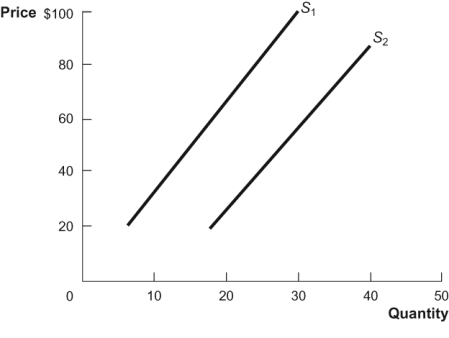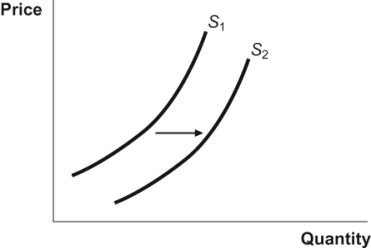A) a change in the demand for the good, but not until the supply actually goes down.
B) a change in the price of the good, but not until the supply actually goes down.
C) a change in the demand for the good even before the supply actually decreases.
D) no change in the demand for the good.
F) B) and C)
Correct Answer

verified
Correct Answer
verified
Multiple Choice
If the government decided to heavily regulate small farmers who grow organic and free-range food, the supply of that food:
A) would increase because the regulations would improve the quality of that food.
B) would decrease because the regulations are like a tax on the food; they make it more expensive to produce.
C) would have no effect, because none of the shifters of supply are affected.
D) would increase because of changing expectations.
F) B) and C)
Correct Answer

verified
Correct Answer
verified
Multiple Choice
If the university president valued a parking space close to the administration building at $500 and paid $30 for a parking permit, he would receive consumer surplus equal to:
A) $30.
B) $470.
C) $500.
D) $530.
F) A) and D)
Correct Answer

verified
Correct Answer
verified
True/False
Demand for a good or service increases when the consumer's income rises, regardless of whether the good is a normal good or inferior good.
B) False
Correct Answer

verified
Correct Answer
verified
Multiple Choice
If producers form expectations that copper prices will be higher in the future, then this will shift the:
A) demand curve for copper to the left.
B) supply curve of copper to the right.
C) demand curve for copper to the right.
D) supply curve of copper to the left.
F) A) and C)
Correct Answer

verified
Correct Answer
verified
Multiple Choice
Which of the following choices correctly illustrates how changes in opportunity costs affect supply?
A) A farmer produces corn and wheat. The price of wheat rises, so he shifts his resources toward wheat and the supply of wheat rises.
B) A fisherman fishes for lobsters and oysters. The price of lobsters rises, so he decides to spend more of his time fishing for oysters because he can make the same amount of money with fewer lobsters.
C) A textbook for economics becomes cheaper, so more students opt to buy that particular textbook.
D) Milk and cereal are complementary goods, so when the price of cereal falls, the quantity supplied of milk rises.
F) A) and B)
Correct Answer

verified
Correct Answer
verified
Multiple Choice
Use the following to answer questions: Figure: Supply Shift  -(Figure: Supply Shift) What would cause the supply curve to shift from S1 to S2 as shown in the diagram?
-(Figure: Supply Shift) What would cause the supply curve to shift from S1 to S2 as shown in the diagram?
A) an increase in taxes on firms' output
B) an increase in the price of inputs used to produce the output
C) a decrease in the number of firms that produce the output
D) a decrease in the wages paid to union workers who produce the output
F) B) and C)
Correct Answer

verified
Correct Answer
verified
Multiple Choice
A firm produces volleyballs and soccer balls. What happens to the supply of soccer balls if the market price of volleyballs increases?
A) The opportunity cost of producing soccer balls rises, so the supply curve of soccer balls increases.
B) The opportunity cost of producing soccer balls falls, so the supply curve of soccer balls decreases.
C) The opportunity cost of producing soccer balls rises, so the supply curve of soccer balls decreases.
D) The opportunity cost of producing soccer balls falls, so the supply curve of soccer balls increases.
F) A) and B)
Correct Answer

verified
Correct Answer
verified
True/False
At low prices, only low-cost producers serve the market, but as market prices rise, higher cost-producers begin to serve the market.
B) False
Correct Answer

verified
Correct Answer
verified
Multiple Choice
Figure: Supply Shift  In the figure, a movement from S1 to S2 represents:
In the figure, a movement from S1 to S2 represents:
A) a decrease in supply.
B) an increase in supply.
C) a decrease in quantity supplied.
D) an increase in quantity supplied.
F) A) and C)
Correct Answer

verified
Correct Answer
verified
Multiple Choice
New production technology in the manufacture of plasma television screens has reduced the number of defective screens. What effect will this have in the market for plasma televisions?
A) The demand curve will increase.
B) The supply curve will increase.
C) The demand and supply curve both increase.
D) The demand curve will decrease.
F) C) and D)
Correct Answer

verified
Correct Answer
verified
Multiple Choice
There are 100 consumers, each of whom values a concert ticket at a unique whole number dollar amount between $1 and $100. One customer is willing to pay $1, a second is willing to pay $2, a third is willing to pay $3, and so on. An unlimited number of concert tickets are on sale for $15 each. What is the total consumer surplus in this market?
A) $3,612.50
B) $4,250.00
C) $4,887.50
D) $5,000.00
F) A) and B)
Correct Answer

verified
Correct Answer
verified
Multiple Choice
A supply curve indicates that:
A) the quantity supplied of a good is higher when the price of that good is higher.
B) the quantity supplied of a good is higher when the price of that good is lower.
C) the supply for a good is higher when the price of that good is lower.
D) the supply for a good is higher when the price of that good is higher.
F) A) and B)
Correct Answer

verified
Correct Answer
verified
Multiple Choice
A change in which factor would shift the supply curve?
A) the price of the good being sold
B) the demand for the product
C) production technology
D) the willingness of consumers to pay
F) A) and B)
Correct Answer

verified
Correct Answer
verified
Multiple Choice
Table: Maximum Willingness to Pay The table shows four individuals' maximum willingness to pay for one pound of bananas. If the market price of bananas is $0.50/lb, what is the total consumer surplus in the market?
A) $4.00
B) $2.50
C) $2.75
D) $4.25
F) A) and C)
Correct Answer

verified
Correct Answer
verified
Multiple Choice
The quantity demanded of a good or service is the amount that:
A) consumers are willing and able to buy at a given price.
B) firms are willing to sell during a given time period at a given price.
C) a consumer would like to buy but might not be able to afford.
D) a consumer needs to consume during a given time period.
F) All of the above
Correct Answer

verified
Correct Answer
verified
Multiple Choice
The quantity demanded is the quantity that buyers are:
A) willing to buy but they cannot afford to pay.
B) able to buy at a given income level but not willing to pay.
C) willing to buy at a given income level.
D) willing and able to buy at a given price.
F) A) and B)
Correct Answer

verified
Correct Answer
verified
True/False
When the price of a good goes down, demand for the good goes down.
B) False
Correct Answer

verified
Correct Answer
verified
True/False
A higher opportunity cost of producing a good increases the supply of that good.
B) False
Correct Answer

verified
Correct Answer
verified
Multiple Choice
Why does supply slope up?
A) At higher prices, suppliers can profitably produce using more expensive techniques and inputs.
B) The cost of producing a given good is the same, no matter how many are produced.
C) Producers charge the maximum price that they can get.
D) If supply did not slope up, it would not intersect with demand.
F) A) and C)
Correct Answer

verified
Correct Answer
verified
Showing 121 - 140 of 255
Related Exams